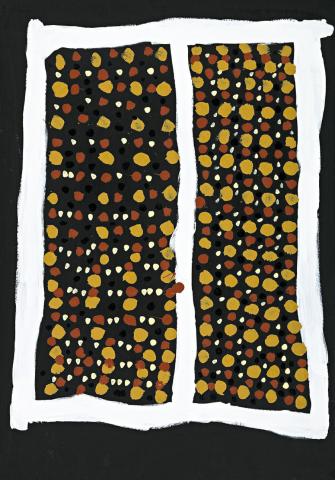BODY MARKS, 1999
PRINCE OF WALES (MIDPUL)
synthetic polymer paint on linen
123.0 x 86.0 cm
inscribed verso: artist's name, title, date, size and cat. EP16/99
Karen Brown Gallery, Darwin (inscribed verso)
Sotheby's, Melbourne, 24 July 2007, lot 166
Private collection, Melbourne
In Larrakia culture the traditional land owners and leaders of ceremonies and dances are referred to as 'King'. In around 1935 Prince of Wales was born Midpul to Larrakia leader King George at Cullen, or Kahlin Beach, which at the time was the untouched bay of Darwin. Both parents passed away when Midpul was very young and he was raised by his mother's family to become a Law and Song Man. His ceremonial skills were legendary and he led many public corroborees for international visitors. As lead dancer for his people he led the ceremonial dance for Queen Elizabeth II on her Commonwealth visit to the Northern Territory during the 1970s and he was forever after known as Prince of Wales. When he suffered an untimely stroke his ceremonial responsibilities were curtailed and he took up painting on canvas as a way to ensure that the ceremonial body decorations of his dance and song endured. In 2001 his standing as a Larrakia painter was recognised when he won the Telstra National Aboriginal and Torres Strait Islander Art Award in the Open Painting Category.
Painted on a black ground, Body Marks, 1999 reinforces the ceremonial body decorations that Prince of Wales wanted to preserve in his painting. The alternate coloured dotting of the body marks in this particular example is contained within a border of bright white, frame the pattern of red, yellow and white dots together to create an intense energy within the work. These are the markings Prince would have originally painted onto the bodies of his clansmen prior to a ceremonial dance but here they are transferred as a permanent record for posterity. The work was painted just over a year after his landmark solo exhibition of 1997 at Gallery Gabrielle Pizzi in Melbourne.
'These paintings ... I paint them on bodies ... young people and old ... ceremony for singing ... dance ... I make the marks'. Midpul, Prince of Wales, speaking about his art.1
1. Notes on Prince of Wales and the Gwalwa Daraniki Land Movement, kindly provided by Grant Smith, Gallery Gabrielle Pizzi
CRISPIN GUTTERIDGE
